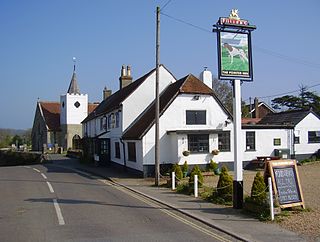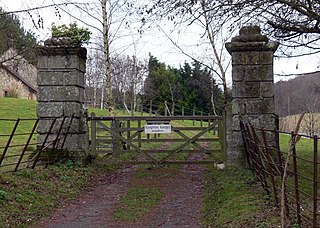Wackland Manor (also Wakelond), is a manor house on the Isle of Wight, situated in the Newchurch parish. It was held in the 13th century under the Lisles of Wootton, but in 1311–12 was said to be held of Ralph de Gorges of Knighton Gorges Manor. [1] At the end of the 13th century it was held by John de la Brigge, from whom it passed with Bridge Court (q.v.) to the Kingstons. It followed the descent of Kingston until 1424, when Robert Dingley and Lewis Meux conveyed it to John Taillour, who was returned in 1431 as holding Wackland. Its descent has not been traced from that time until the end of the 18th century. [1] Some time before 1786 it must have been in the possession of Thomas Davis, as he left a charge of 20s. upon it for charities. [1] In the early part of the 19th century Wackland was the residence of a hunting farmer, well known as 'Squire' Thatcher, who kept and hunted a pack of harriers. Mr. E. Carter was lord of Wackland in 1878, and as of 1912 it belonged to the trustees of the late Mr. Thomas F. Perrott. [1]

The Isle of Wight is a county and the largest and second-most populous island in England. It is in the English Channel, between 2 and 5 miles off the coast of Hampshire, separated by the Solent. The island has resorts that have been holiday destinations since Victorian times, and is known for its mild climate, coastal scenery, and verdant landscape of fields, downland and chines.

Newchurch is a village and civil parish on the Isle of Wight. It is located between Sandown and Newport in the southeast of the island. Anthony Dillington, owner of the Knighton Gorges Manor in Newchurch wrote to his son Robert in 1574 that, "This is the very Garden of England, and we be privileged to work in it as Husbandmen......." Newchurch obtained its name from the new church built in 1087 by the Norman monks of Lyra. The Newchurch Parish for many centuries stretched from the north to south coasts of the Island; by the early Nineteenth Century the growing resort towns of Ventnor and Ryde were included within its boundaries. The present day parish includes Newchurch Village, Apse Heath, Winford, Whiteley Bank, Alverstone, Alverstone Garden Village, Queen's Bower, Princelett and Mersley.

Wootton is a large village, civil parish and electoral ward with about 3,000 residents on the Isle of Wight, first recorded around the year 1086.






